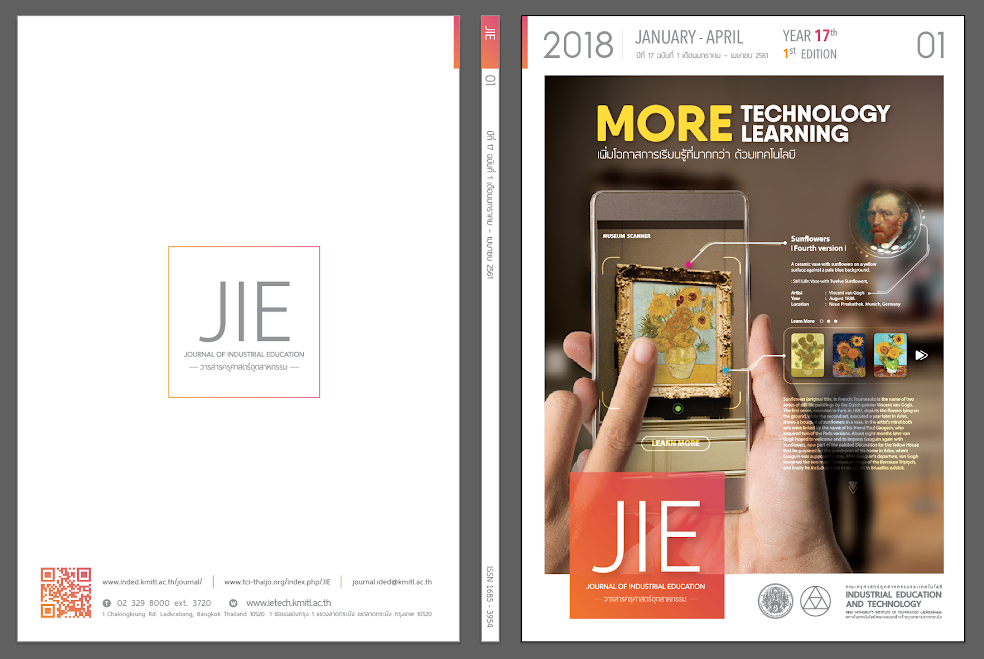A STRUCTURAL EQUATION MODEL OF FACTORS EFFECTING TO VISIONARY LEADERSHIP OF VOCATIONAL ADMINISTRATORS UNDER THE VOCATIONAL EDUCATION COMMISSION OFFICE
Keywords:
Structural Equation Model, Visionary Leadership, Administrators, LeadershipAbstract
The purposes of this research were to 1) study a structural equation model of factors effecting to visionary leadership of vocational administrators, 2) investigate the consistency of the development of a structural equation model of factors effecting to visionary leadership and the empirical data and 3) study guideline for development visionary leadership of vocational administrators. The sample is 446 vocational education colleges and 6 experts. The research instruments consist of questionnaire and interview. The statistics used for data analysis were descriptive statistics, structural equation model analysis and content analysis. The research results indicated that the model was conformed to empirical data at a good level. A structural equation model of factors effecting to visionary leadership of vocational administrators were the communication, learning person, emotional intelligence, creativity and organization climate. The causal model revealed 76 percent on the variance of visionary leadership. Guidelines to develop visionary leadership of vocational administrators were: 1) the self development by obtaining or acquiring new knowledge and 2) the work development by creates flexible organization to achieve its goals.
References
[2] Narkwiboonwong, S. 2016. Vocational leadership. Bangkok: Kasetsart University.
[3] Kanhan. R. L. 2008. The social psychology of organizations. New York: Wiley.
[4] Sergiovanni, M. 1993. Leadership: System thinkers in action. London: Sage.
[5] Weisinger, B. 1998. The essentials of school leadership. London: Paul Chapman.
[6] Koys, G. 1991. Insiders and Outsiders: Women’s movement and organizational effectiveness. Canadian Review of Sociology and Antropology, 33(3), p. 391-410.
[7] Lunenburg, H. 1991. Handbook of leadership: A survey of theory. New York: The Free Press.
[8] Torance, I. 1962. Effective strategic leadership. London: Macmillan.
[9] Kanyankitti, P. 2014. Educational leaders. Journal of Education, 13(1), p. 44-52.
[10] Nanus, B. 1992. Visionary leadership. San Francisco: Jossey-Bass.
[11] Manning, W. and Robertson, R. 2002. Strategies for developing. New Jersey: Prentice-Hall.
[12] Kantabutra, F. and Avery, M. 2004. Educational leadership. New Jersey: Prentice – Hall.
[13] Groves, V. 2005. Lesson in strategic leadership for service. New York: McGraw.
[14] Thomas, G. 2005. Leadership behavior. New Jersey: Career Press.
[15] Wansi, C. 2007. Model of causal relationship of factors affecting the vision of school administrators. Basic Thesis. Educational Administration, Naresuan University.
[16] Lonlưa, N. 2012. Structural equation model of vision leadership of basic school administrators. Ph.D. thesis Educational Administration, KhonKaen University.
[17] Chuchom, O., Sukhan, A. and Chuawanli, W. 1999. Vocational education. Bangkok: Partnership.
[18] Ho̜mbuppa, S. 1999. Creative thinking with intelligence emotional intelligence the ability of primary 6 student. Master Thesis Educational Measurement, Naresuan University.
[19] Willium, L. 1994. Effective classroom management. Journal of Elementary School, 8(2), p. 219-231.
[20] Hay, W. and McBer, R. 2000. Managing effective organization: An introduction. Boston: Kent publishing company.
[21] Rogers, L. 1959. Taxonomy of educational objectives handbook. New York: David McKay Co Inc.
[22] Smith, K. and Hildreth, J. 1971. My personal journey toward professionalism. Young Children, 49(6), p. 69-71.
[23] Osborn, P. 1973. Principles of language learning and teaching. New York: Pearson Education.
[24] Litwin, B. and Stringer, H. 1968. Tolerance of ambiguity: A trait of the creative personality. Creativity Research Journal, 25(2), p. 232-237.
[25] Tanyatorn, R. 2010. Education and human resource. Journal of Education, 5(1), p. 103-117.
[26] Palasak, W. 2005. Education reform: an overhaul of the way of survival. 2rd ed. Bangkok: Sodsri-Saritwong Foundation.
[27] Steers, D. and Porter, B. 1979. Creating training miracles. Sydney: Prentice Hall.
[28] Sanrattana, W. and Phrưk, S. 2002. School administrators and organizational atmosphere. Journal of Education, 25(2), p. 17-28.
[29] Peter, S. 1990. A new look at management communication in management. San francisco: McGraw-Hill Book Company.
[30] Boonphak, K and Innoi, P. 2017. Learning management to Thailand 4.0: Active learning. Journal of Industrial Education, 16(1), p. 1-4.
Downloads
Published
How to Cite
Issue
Section
License
"The opinions and contents including the words in papers are responsibility by the authors."
"ข้อคิดเห็น เนื้อหา รวมทั้งการใช้ภาษาในบทความถือเป็นความรับผิดชอบของผู้เขียน"



